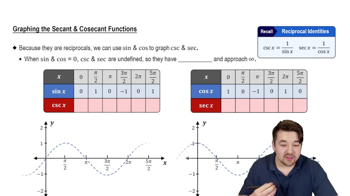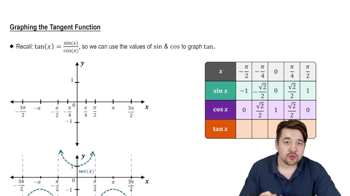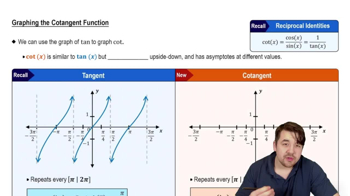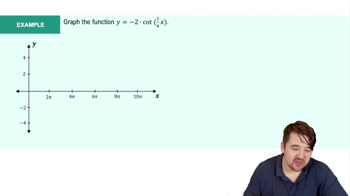Table of contents
- 0. Functions7h 52m
- Introduction to Functions16m
- Piecewise Functions10m
- Properties of Functions9m
- Common Functions1h 8m
- Transformations5m
- Combining Functions27m
- Exponent rules32m
- Exponential Functions28m
- Logarithmic Functions24m
- Properties of Logarithms34m
- Exponential & Logarithmic Equations35m
- Introduction to Trigonometric Functions38m
- Graphs of Trigonometric Functions44m
- Trigonometric Identities47m
- Inverse Trigonometric Functions48m
- 1. Limits and Continuity2h 2m
- 2. Intro to Derivatives1h 33m
- 3. Techniques of Differentiation3h 18m
- 4. Applications of Derivatives2h 38m
- 5. Graphical Applications of Derivatives6h 2m
- 6. Derivatives of Inverse, Exponential, & Logarithmic Functions2h 37m
- 7. Antiderivatives & Indefinite Integrals1h 26m
0. Functions
Graphs of Trigonometric Functions
Problem 99
Textbook Question
Identify the amplitude and period of the following functions.
q(x)=3.6cos(24πx)
 Verified step by step guidance
Verified step by step guidance1
The function given is q(x) = 3.6 \cos\left(\frac{\pi x}{24}\right). This is a cosine function of the form a \cos(bx), where 'a' is the amplitude and 'b' affects the period.
Identify the amplitude: In the function q(x) = 3.6 \cos\left(\frac{\pi x}{24}\right), the coefficient 'a' in front of the cosine function is 3.6. Therefore, the amplitude is 3.6.
Determine the period: The period of a cosine function a \cos(bx) is given by \frac{2\pi}{b}.
In the function q(x) = 3.6 \cos\left(\frac{\pi x}{24}\right), the value of 'b' is \frac{\pi}{24}.
Calculate the period using the formula: Substitute b = \frac{\pi}{24} into the period formula \frac{2\pi}{b} to find the period of the function.
Recommended similar problem, with video answer:
 Verified Solution
Verified SolutionThis video solution was recommended by our tutors as helpful for the problem above
Was this helpful?

 5:53m
5:53mWatch next
Master Graph of Sine and Cosine Function with a bite sized video explanation from Nick
Start learningRelated Videos
Related Practice








